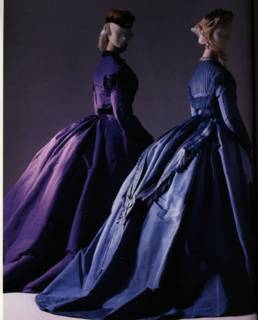Wigs (or 18th century hair, if you're blessed with hair long enough) has always fascinated me. I remember reading about La Belle Poule (the ship-in-the-hair style) when I was a kid and marveling at how silly it was. Now, of course, I'm obsessed enough with the 18th century that I'd actually give it a try. :) I can't remember where I came across this 18th century illustration of hair styles, but I love that each one has its own name:

I was thrilled to make it
to the Wig Maker during my latest trip to Williamsburg. Check out their new Facebook page. They're not always open on the weekend when I tend to visit, so it was a treat. The wig maker was restyling the governor's wife's wig. It still blows my mind to think that ladies would shave their heads if they wanted to wear a wig. I wonder how common ladies wigs were vs. getting your own hair styled. Does anyone know?

There were all sorts of new wigs on display. In the past, it seems like the store generally had men's wigs on display, but this time there were tons of ladies' wigs. This one is actually a man's wig (can you imagine what a dandy a guy would have to be to wear one of these?). It makes me think of the hairstylist Leonard in Sophia Coppola's "Marie Antoinette."

I LOVE this wig, because it's my hair color and has peacock feathers. I have no idea what's up with the scissors. I think maybe they were on the shelf in the background (not IN the wig), but I didn't notice it when I took the photo.

I love the one on the left. The pretty pin curls toward the top are my favorite.

And here's my favorite. What's not to love? It's the powdery ideal of the 1770's and doesn't look anything like the horrid white wigs costume shops sell (I do realize comparing the quality between costume wigs and the Williamsburg Wig Maker is like comparing a Fiat to a Ferrari, but that's what came to mind).

Check out all the little side curls piled one on top of the other! That, combined with the twisted chignon and feathers, it's just to die for!! I want one. I'm not very talented when it comes to hairstyling, or I'd have already bought a wig and tried my own hand at creating an 18th century poof. Kendra has a great tutorial on how to
style a 1770's wig, and Abby of "Stay-ing Alive" has a
great 1780's hedgehog tutorial if you are more talented at hairstyling.
I'm hoping that there will be a wig workshop in my future or that I cajole my way onto the wigmaker's wait list.
 My half-boned stays are coming along quite nicely. I have sewn in the lining (I'm loving the blue gingham!!) and gotten the edges partially bound.
My half-boned stays are coming along quite nicely. I have sewn in the lining (I'm loving the blue gingham!!) and gotten the edges partially bound. The top edge is complete, but as these pins prove, I'm still working on finishing up the bottom half. It is, of course, the more difficult half thanks to all the tabs.
The top edge is complete, but as these pins prove, I'm still working on finishing up the bottom half. It is, of course, the more difficult half thanks to all the tabs. I did get the eyelets all nicely hand-bound. I found some beautiful silk embroidery floss when I was in Charlottesville a few weeks ago and used it. I still prefer silk buttonhole twist, but since that's not always available the embroidery thread was a nice substitute.
I did get the eyelets all nicely hand-bound. I found some beautiful silk embroidery floss when I was in Charlottesville a few weeks ago and used it. I still prefer silk buttonhole twist, but since that's not always available the embroidery thread was a nice substitute. Another reason progress has slowed down a bit on my projects is because I'm working on a commission. It's a fully boned pair of 18th century stays. I'll post pictures once I'm finished, but here's a sneak peak. Isn't the color fabulous? I love the gold silk.
Another reason progress has slowed down a bit on my projects is because I'm working on a commission. It's a fully boned pair of 18th century stays. I'll post pictures once I'm finished, but here's a sneak peak. Isn't the color fabulous? I love the gold silk. I ordered 50 yards of plastic boning for the commission stays. I was really worried that I hadn't ordered enough...but here's what was left in the end. Talk about ordering just the right amount!
I ordered 50 yards of plastic boning for the commission stays. I was really worried that I hadn't ordered enough...but here's what was left in the end. Talk about ordering just the right amount!

















































